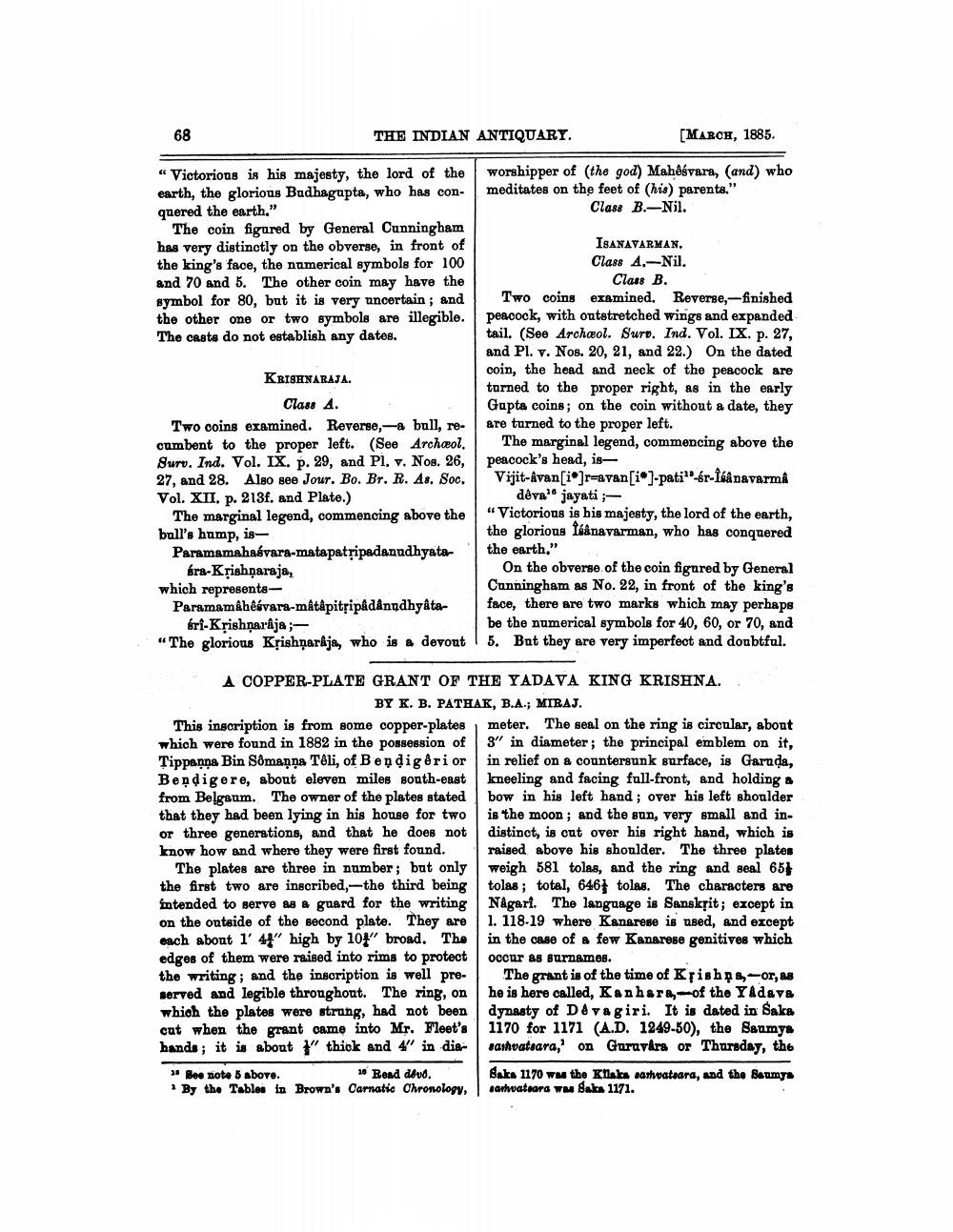________________
68
"Victorious is his majesty, the lord of the earth, the glorious Budhagupta, who has conquered the earth."
The coin figured by General Cunningham has very distinctly on the obverse, in front of the king's face, the numerical symbols for 100 and 70 and 5. The other coin may have the symbol for 80, but it is very uncertain; and the other one or two symbols are illegible. The casts do not establish any dates.
KRISHNARAJA. Class A.
THE INDIAN ANTIQUARY.
Two coins examined. Reverse,-a bull, recumbent to the proper left. (See Archæol. Surv. Ind. Vol. IX. p. 29, and Pl. v. Nos. 26, 27, and 28. Also see Jour. Bo. Br. R. As. Soc. Vol. XII. p. 213f. and Plate.)
The marginal legend, commencing above the bull's hump, is
Paramamahaśvara-matapatṛipadanudhyata
árn-Krishnaraja,
which represents
Paramamâhêévara-mâtâpitripâdânadhyâta
irl-Krishnarja
"The glorious Krishnaraja, who is a devout
[MARCH, 1885. worshipper of (the god) Mahêśvara, (and) who meditates on the feet of (his) parents." Class B.-Nil.
This inscription is from some copper-plates which were found in 1882 in the possession of Tippanna Bin Sômanna Téli, of Bendigêrior Bendigere, about eleven miles south-east from Belgaum. The owner of the plates stated that they had been lying in his house for two or three generations, and that he does not know how and where they were first found.
The plates are three in number; but only the first two are inscribed,-the third being intended to serve as a guard for the writing on the outside of the second plate. They are each about 1' 4" high by 101" broad. The edges of them were raised into rims to protect the writing; and the inscription is well preserved and legible throughout. The ring, on which the plates were strung, had not been cat when the grant came into Mr. Fleet's hands; it is about " thick and 4" in diaBee note 5 above. 10 Read dévé. By the Tables in Brown's Carnatic Chronology,
ISANAVARMAN. Class A.-Nil. Class B.
Two coins examined. Reverse,-finished peacock, with outstretched wings and expanded tail. (See Archeol. Sure. Ind. Vol. IX. p. 27, and Pl. v. Nos. 20, 21, and 22.) On the dated coin, the head and neck of the peacock are turned to the proper right, as in the early Gupta coins; on the coin without a date, they are turned to the proper left.
The marginal legend, commencing above the peacock's head, isVijit-Ivan[i]ravan[i*]-pati"-ár-Înva
dêva1 jayati;
"Victorious is his majesty, the lord of the earth, the glorious féânavarman, who has conquered
the earth."
A COPPER-PLATE GRANT OF THE YADAVA KING KRISHNA.
BY K. B. PATHAK, B.A.; MIRAJ.
On the obverse of the coin figured by General Cunningham as No. 22, in front of the king's face, there are two marks which may perhaps be the numerical symbols for 40, 60, or 70, and 5. But they are very imperfect and doubtful.
meter. The seal on the ring is circular, about 3" in diameter; the principal emblem on it, in relief on a countersunk surface, is Garuda, kneeling and facing full-front, and holding a bow in his left hand; over his left shoulder is the moon; and the sun, very small and indistinct, is cut over his right hand, which is raised above his shoulder. The three plates weigh 581 tolas, and the ring and seal 65 tolas; total, 646 tolas. The characters are Nagari. The language is Sanskrit; except in 1. 118-19 where Kanarese is used, and except in the case of a few Kanarese genitives which occur as surnames.
The grant is of the time of Krishna,-or, as he is here called, Kanhara,-of the Yadava dynasty of Devagiri. It is dated in Saka 1170 for 1171 (A.D. 1249-50), the Saumys sashvatsara,' on Guravåra or Thursday, the
Saka 1170 was the Kilaka samvatsara, and the Saumys samvatsara was Saka 1171.




